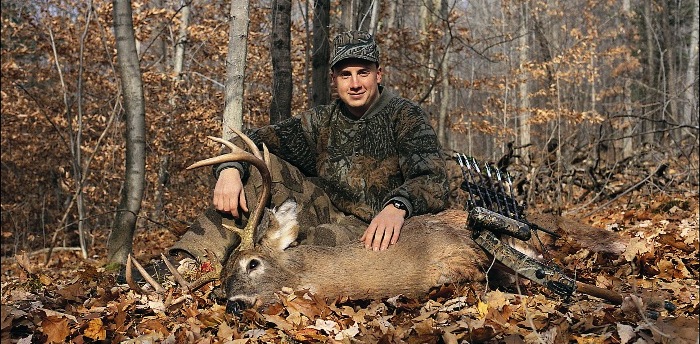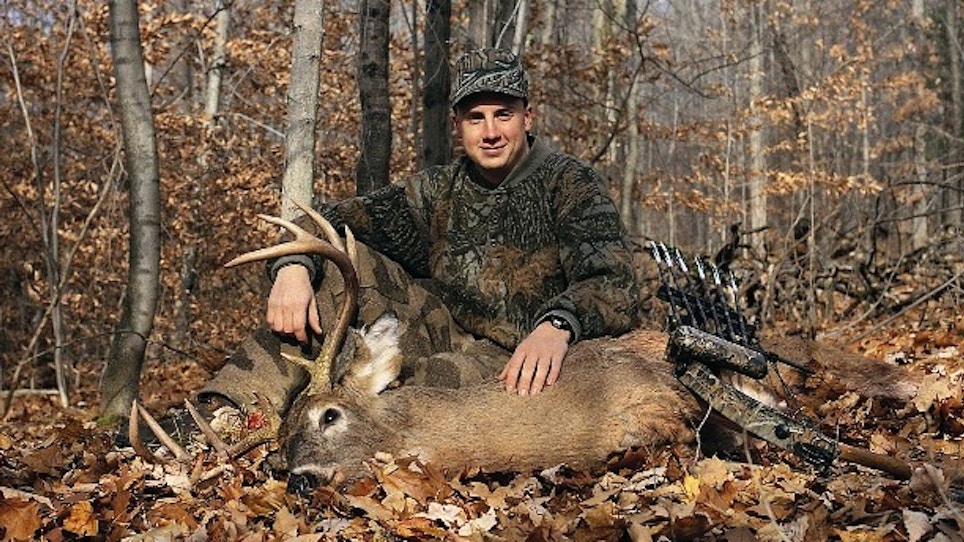“Kindred Spirits” has no electricity, yet the insulated walls of this mountaintop hunting camp incubate camaraderie and family bonding like no penthouse on earth. In 1990, Craig Dougherty purchased 150 acres of the poorest deer habitat imaginable. The abandoned farm on the western slope of a New York mountain was overgrown with scrub brush, its productivity in complete decline. Mast was limited to a few surviving hardwoods and an old apple orchard abandoned by its owner 30 years previously. The few surviving fruit trees faced stiff competition from saplings and an overstory that starved them of light.
During the next 10 years, the property metamorphosed into a bowhunter’s whitetail heaven thanks to scientific wildlife management and plenty of hard habitat work. In fact, Dougherty’s son Neil made a life-altering decision. He chose not to go back to college the fall of his senior year. Instead, he spent the deer season at Kindred Spirits, hunting as often as he wished while inhaling huge quantities of mountain air and renewing his soul.
“I had three goals for the season,” remembers the lad, reflecting on the experience. “To take a Pope & Young buck, harvest a wild turkey, and see a black bear.”
During the ’90s the Doughertys had spent many weekends and summer vacations working on the property, practicing Quality Deer Management (QDM). Neil’s goals were ambitious. In 10 years of hunting, no one had taken a truly record-class deer on the property. Turkeys? Yes, a flock was often seen, and Kindred’s dense cover seemed bear-friendly. Ironically, striving for these goals provided an outdoor education with an unanticipated impact.
P&Y Recordbook Buck
Opening day, October 15, Kindred Spirits’ environs felt more like the Deep South than Northern Tier. Neil, his dad, and three friends hunted the camp, and their reports were promising. Although no one unleashed an arrow, everyone saw deer, and several archers passed year-and-a-half bucks. Maturing the age structure of resident deer was one of the camp’s first objectives. Not a hard and fast rule, yet guests were encouraged to pass younger bucks.
Throughout October, weather conditions fluctuated yet were usually warm and conducive to nocturnal deer activity. As one day rolled into the next, Neil increasingly understood the movements of wildlife and relished the opportunity to experience the outdoors on a deeper personal level. As the month drew to a close, he had found many bear tracks, seen several flocks of turkeys, yet had not located the big antlers he sought.
Close friend Steve Story visited on weekends, and the duo often scouted remote sections of the property. One day, dressed in T-shirts to accommodate the hot weather, they spent midday scouting and got an exciting surprise. They jumped a big buck in the process of tending a doe. To their amazement, the buck chased the doe right toward them. The two men were about 75 yards apart in thick cover, and each got a close look at the majestic whitetail as it dogged the doe. The men were confident this deer would make book with plenty to spare.
Returning to camp, they held a “power meeting” to develop a strategy. Their earlier encounter occurred in terrain called “the hole,” a steep, thick section that was rarely hunted. Rather than risk spooking the buck from the area, they chose to hunt its perimeter, a strategy that did not succeed, yet did not spook the buck.
During the next week, Neil hunted the “hole” area several times, choosing stands that had a favorable wind. Gone was the need for immediate success. He sought to understand the habits of his quarry and close the distance for a shot. Late in the week, Neil spotted the buck for a second time, coming from the “hole” and reeking of rut.
Saturday morning, Katie, Neil’s girlfriend, and Steve joined forces. Both the morning and afternoon hunts were uneventful. Each archer spotted deer of varying age classes, yet not the big one. Sunday afternoon, Neil dropped to the lowest point on the property and hunted the base of the hole.
About 45 minutes before dark, he heard a deer approaching, but thought it was a 6-point that had passed his stand several times. “Suddenly, the deer appeared and my heart stopped,” Neil remembered. “It was him!” The deer walked below the stand about 40 yards, hit a logging road, and turned directly uphill.
“He was moving quickly down the logging road and would pass through a shooting lane at about 30 yards. I had the tree ranged in and felt confident about my accuracy. When the buck passed behind a mass of grapevines, I drew silently. Two steps before the opening, the buck turned toward me, sidestepping the shooting lane. Then, for whatever reason, it turned and walked away. I was still at full draw as the deer passed through a small opening, and I released.”
Neil waited half an hour until he could stand the suspense no longer. Climbing down and investigating, he found an arrow covered with blood. Knowing he’d need help, he located Steve, who practically jumped from his stand when he heard the news.
 After the shot, the buck had raced out of the hole, and Neil and Steve were soon on the track. Seventy-five yards along the spoor, the hunt came to a crashing crescendo. Not only did the 136 P&Y buck lay still in the leaves, it expired just 10 yards from the only access point to this dastardly location. Recovery was swift and jubilant.
After the shot, the buck had raced out of the hole, and Neil and Steve were soon on the track. Seventy-five yards along the spoor, the hunt came to a crashing crescendo. Not only did the 136 P&Y buck lay still in the leaves, it expired just 10 yards from the only access point to this dastardly location. Recovery was swift and jubilant.
Next: Falling In Love With Bowhunting






